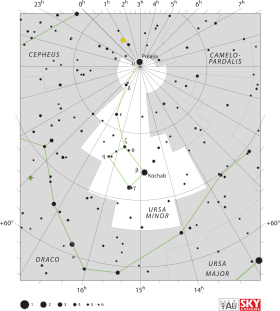Orbite
Demi-grand axe (a )
0,464 ± 0,083 ″
Excentricité (e )
0,961 ± 0,014
Période (P )
171,62 ± 8,68 a
Inclinaison (i )
135,2 ± 10,5°
Argument du périastre (ω )
274,0 ± 22,4°
Longitude du nœud ascendant (Ω )
123,4 ± 32,6°
Époque du périastre (τ )
1 904,15 ± 2,89 JJ
Désignations
modifier
Pi2 Ursae Minoris (π2 Ursae Minoris / π2 UMi) est une étoile binaire de la constellation circumpolaire de la Petite Ourse d'une magnitude apparente combinée de +6,95[ 2] œil nu . Le système est distant d'environ ∼ 390 a.l. pc Soleil [ 1] vitesse radiale de −32,1 km/s [ 6]
Les deux étoiles sont distantes en moyenne de 0,464 seconde d'arc dans le ciel, et elles effectuent une orbite l'une autour de l'autre avec une période d'environ 170 ans[ 4] 2 Ursae Minoris A, est une étoile jaune-blanc de la séquence principale de type spectral F1V[ 3] [ 11] 2 Ursae Minoris B, est une naine jaune de type G0[ 4] [ 11]
↑ a b c d e et f (en) F. van Leeuwen , « Validation of the new Hipparcos reduction », Astronomy & Astrophysics vol. 474, no 2, novembre 2007 , p. 653–664 (DOI 10.1051/0004-6361:20078357 Bibcode 2007A&A...474..653V arXiv 0708.1752 ↑ a et b (en) E. Høg et al. The Tycho-2 catalogue of the 2.5 million brightest stars », Astronomy & Astrophysics vol. 355, 2000 , p. L27 (DOI 10.1888/0333750888/2862 Bibcode 2000A&A...355L..27H ↑ a et b (en) N. Ginestet , J. M. Carquillat et C. Jaschek , « Spectral classifications in the near infrared of stars with composite spectra. III. Study of a sample of 137 objects with the Aurelie spectrograph », Astronomy & Astrophysics vol. 134, no 3, 1999 , p. 473 (DOI 10.1051/aas:1999444 Bibcode 1999A&AS..134..473G ↑ a b c et d (en) William I. Hartkopf , Brian D. Mason et Theodore J. Rafferty , « Speckle Interferometry at the Usno Flagstaff Station: Observations Obtained in 2003-2004 and 17 New Orbits », The Astronomical Journal vol. 135, no 4, 2008 , p. 1334 (DOI 10.1088/0004-6256/135/4/1334 Bibcode 2008AJ....135.1334H lire en ligne ) ↑ a et b (en) E. Anderson et Ch. Francis , « XHIP: An extended hipparcos compilation », Astronomy Letters vol. 38, no 5, 2012 , p. 331 (DOI 10.1134/S1063773712050015 Bibcode 2012AstL...38..331A arXiv 1108.4971 ↑ a et b (en) J. Holmberg , B. Nordström et J. Andersen , « The Geneva-Copenhagen survey of the Solar neighbourhood II. New uvby calibrations and rediscussion of stellar ages, the G dwarf problem, age-metallicity diagram, and heating mechanisms of the disk », Astronomy & Astrophysics vol. 475, no 2, novembre 2007 , p. 519-537 (DOI 10.1051/0004-6361:20077221 Bibcode 2007A&A...475..519H arXiv arXiv:0707.1891 ↑
(en) A. G. A. Brown et al. Gaia collaboration), « Gaia Data Release 2 : Summary of the contents and survey propertiesAstronomy & Astrophysics vol. 616, août 2018 , article no A1 (DOI 10.1051/0004-6361/201833051 Bibcode 2018A&A...616A...1G arXiv 1804.09365 Notice Gaia DR2 pour cette source sur VizieR .
↑ (en) Caroline Soubiran et al. The PASTEL catalogue: 2016 version », Astronomy & Astrophysics vol. 591, juin 2016 , p. 7 (DOI 10.1051/0004-6361/201628497 Bibcode 2016A&A...591A.118S arXiv arXiv:1605.07384 ↑ a et b (en) L. Casagrande et al. New constraints on the chemical evolution of the solar neighbourhood and Galactic disc(s). Improved astrophysical parameters for the Geneva-Copenhagen Survey », Astronomy & Astrophysics vol. 530, no A138, 2011 , p. 21 (DOI 10.1051/0004-6361/201016276 Bibcode 2011A&A...530A.138C arXiv 1103.4651 ↑ (en) * pi.02 UMi -- High proper-motion Star sur la base de données Simbad Centre de données astronomiques de Strasbourg .↑ a et b (en) « Sixth Catalog of Orbits of Visual Binary Stars (consulté le 7 août 2019 )
Liens externes
Information related to Pi2 Ursae Minoris
